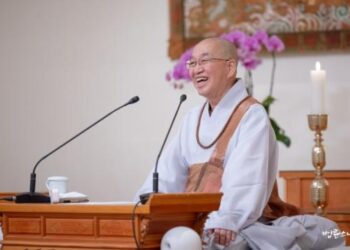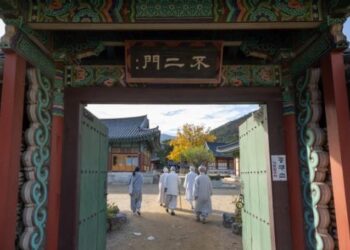Nov 13, 2025 – The Peace Foundation’s 21st Anniversary Symposium
Hello. Today marks the symposium commemorating the 21st anniversary of The Peace Foundation. Autumn is deepening. The autumn foliage has colored various spots throughout downtown Seoul.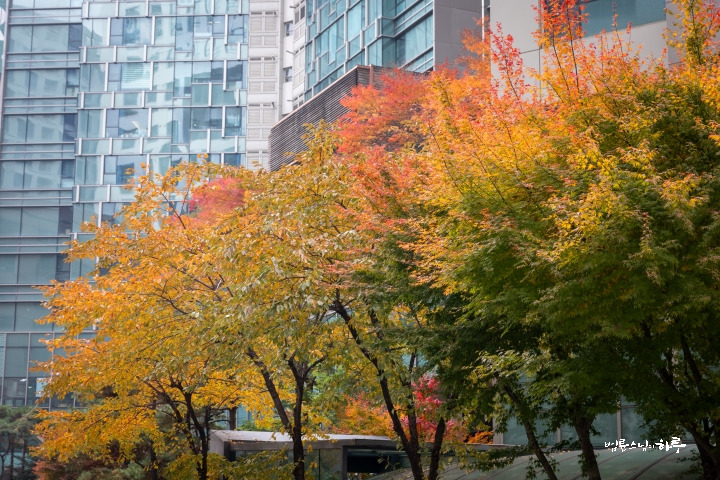
After completing morning practice and meditation, Sunim worked indoors in the morning. When a guest arrived, he headed to the Jungto Social and Cultural Center. Arriving around noon, he continued conversations over lunch with the guest, then moved to the 9th-floor auditorium where The Peace Foundation symposium was being held.
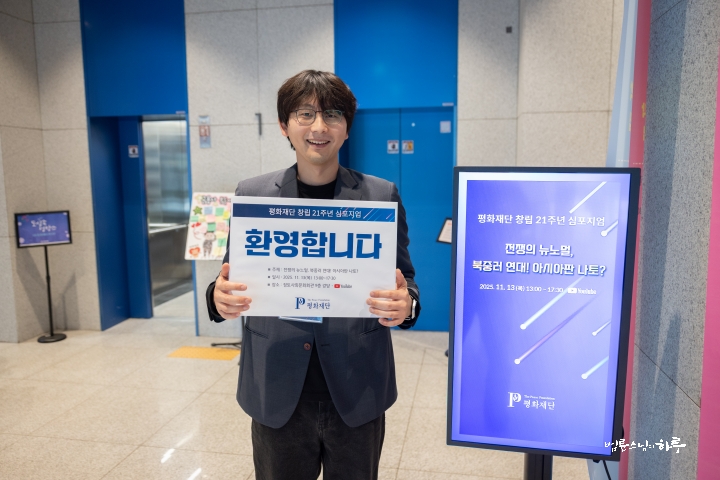
With the moderator, presenters, and panelists all positioned in front of the cameras, The Peace Foundation’s 21st anniversary symposium began precisely at 1 PM. A live broadcast was also conducted so anyone could participate online.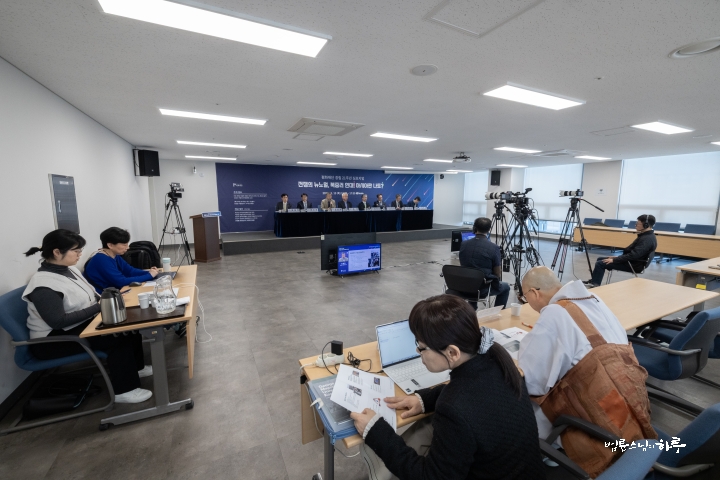
With over 200 people connected to the live stream, participants first watched a video showcasing The Peace Foundation’s journey over the past 21 years. Everyone gave a big round of applause for the history of steadfast activities in peace research, peace education, and peace movements without losing the original spirit.
After the video ended, Dr. Cho Min (Advisory Committee Member of The Peace Foundation), who was moderating, introduced the theme of today’s symposium.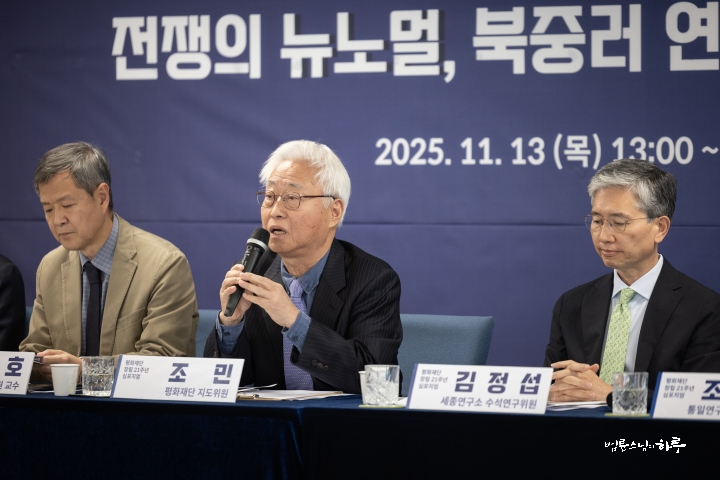
The New Normal Era of War: North Korea-China-Russia Alliance and the Possibility of Creating an Asian NATO?
“This year marks the new normal era of war. Currently, wars are being waged in eight locations worldwide, and among them, the Russia-Ukraine war has already continued for four years. Particularly since last October, a shadow has fallen over the Korean Peninsula due to North Korea’s deployment and participation in Russia. We organized today’s symposium to gather wisdom on how to establish Korea’s position and role amid such serious security crises. We will conduct presentations and discussions on two themes in this new normal era of war: ‘North Korea-China-Russia Alliance’ and ‘The Possibility of Creating an Asian NATO?'”
First, Professor Shin Sung-ho from Seoul National University’s Graduate School of International Studies presented on the topic “North Korea-China-Russia Alliance and the Reverse Kissinger Strategy.”
Professor Shin Sung-ho explained the U.S.-China détente strategy during the Nixon-Kissinger era, analyzing that while the “Kissinger Strategy” involved the U.S. improving relations with China to manage the Cold War with the Soviet Union, today’s Trump administration’s plan to check China by improving relations with Russia is the “Reverse Kissinger Strategy.” However, he assessed that this strategy has a low probability of success because China and Russia currently share a common worldview of an alternative international order, and Trump’s impulsive diplomatic style and failure in alliance management make it difficult to draw Russia toward the U.S. He emphasized that these changes provide important implications for Korea, stating that while maintaining the Korea-U.S. alliance amid the uncertainty in U.S. foreign policy, Korea must strengthen its self-defense capabilities and simultaneously prepare a proactive long-term peace strategy including inter-Korean dialogue.
Next, Dr. Kim Jung-seop, Senior Research Fellow at the Sejong Institute, presented on “An Asian NATO, Is It Possible?”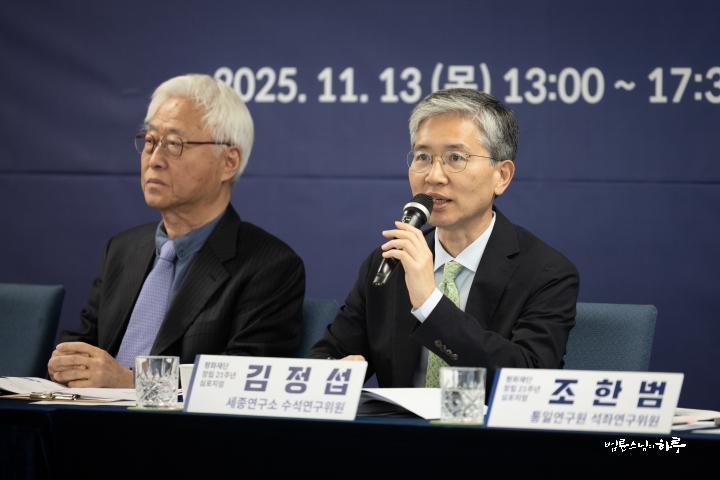
Dr. Kim Jung-seop explained NATO’s history and structure, assessing that creating an “Asian NATO” – a multilateral alliance of the same form in Asia – would be extremely difficult. He pointed out that unlike Europe, Asia has weak common identity, strong historical aversion to Japan, and varying security priorities and threat perceptions of China by country. He also analyzed that East Asia is deeply economically intertwined with China, making it difficult to form an exclusive military alliance, and that geographical and strategic conditions are unsuitable for forming a community of shared destiny like Europe. While the U.S. has recently been expanding its “lattice-like security structure” through Quad, AUKUS, and Korea-U.S.-Japan cooperation, he emphasized that this is unlikely to develop into a collective defense system like NATO, and that the “Asian NATO” concept is an anachronistic approach that is neither realistic nor strategically desirable amid China’s rise and U.S. changes.
Following this, five experts from various fields continued with panel discussions.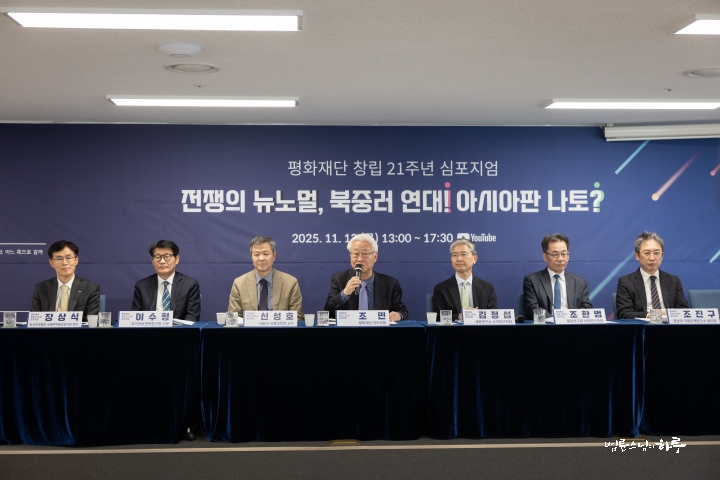
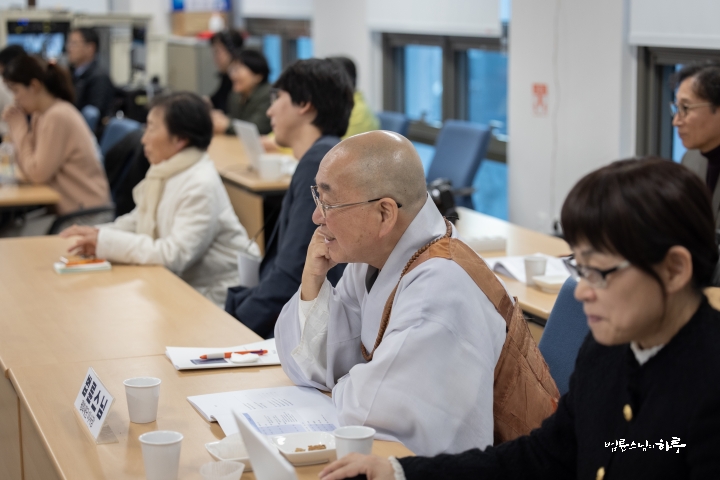
Jung Sang-sik, President of the Institute for International Trade, stated that Korea’s “security with the U.S., economy with China” strategy no longer works amid U.S.-China competition and the North Korea-China-Russia alliance. He emphasized a pragmatic strategy of strengthening security alliances, diversifying economic supply chains, and managing selective cooperation and competition with China.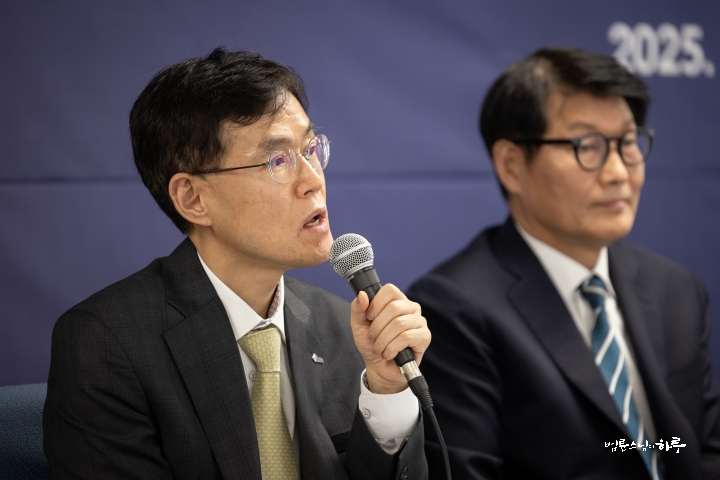
Cho Jin-gu, Director at the Institute for Far Eastern Studies, viewed Japan’s “Asian NATO” concept as having low feasibility due to political, constitutional, and geographical constraints and neighboring countries’ wariness. He suggested that Korea needs balanced diplomacy considering China and ASEAN while maintaining Korea-U.S.-Japan cooperation.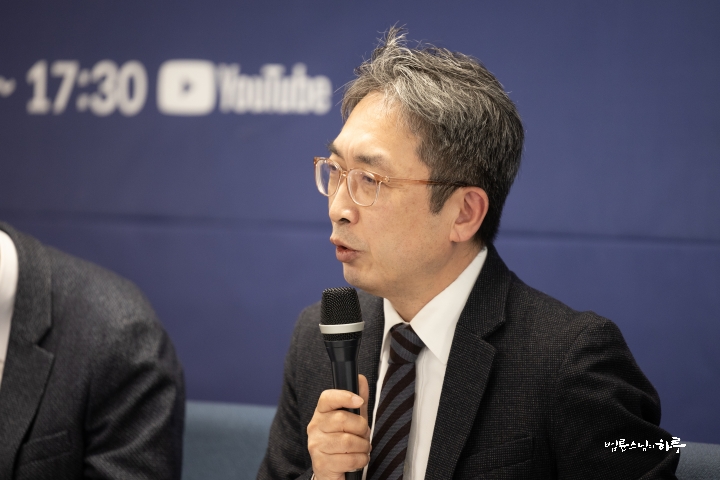
Cho Han-beom, Research Fellow at the Korea Institute for National Unification, analyzed that a “security with the North, economy with the South” structure has emerged as Russia strengthened military cooperation with North Korea after the Ukraine war. He argued that Korea should not be trapped in a new Cold War structure but should devise a new northern diplomacy strategy utilizing differences in interests among North Korea, China, and Russia.
Professor Lee Jung-chul from Seoul National University’s Department of Political Science and International Relations stated that viewing East Asia through a new Cold War structure is exaggerated. He emphasized that Korea should actively respond to changing U.S. strategies and guard against rigid bloc logic while considering the complex interests of the U.S., China, Russia, and North Korea.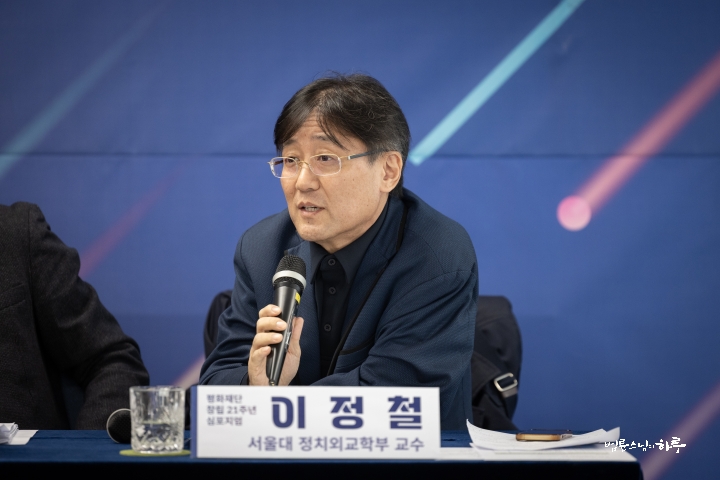
Lee Soo-hyung, Advisor at the Institute for National Security Strategy, analyzed that while North Korea-China-Russia cooperation appears to be strengthening, China is wary of bloc formation, making actual trilateral alliance limited. He predicted that the “Reverse Kissinger Strategy” and Asian NATO have low success probability due to the worldview shared by China and Russia, and that anti-China alliances in Asia would result in limited cooperation centered on Japan.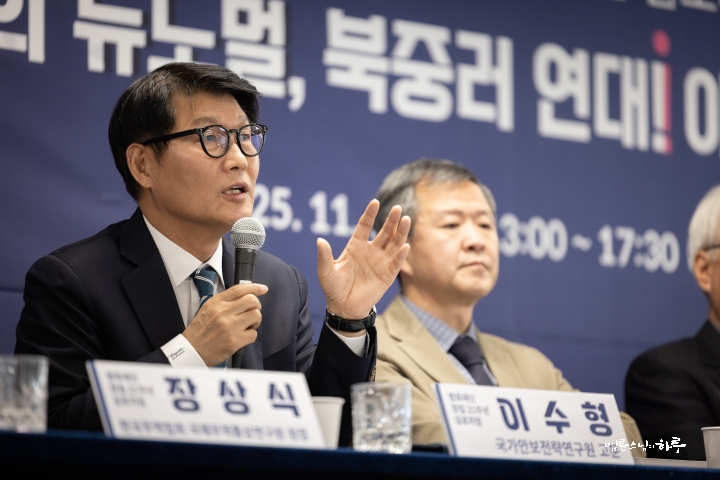
As the discussion grew increasingly heated, a brief break was taken. While viewers watching the live broadcast took a moment to clear their heads, the participating experts took commemorative photos with Sunim.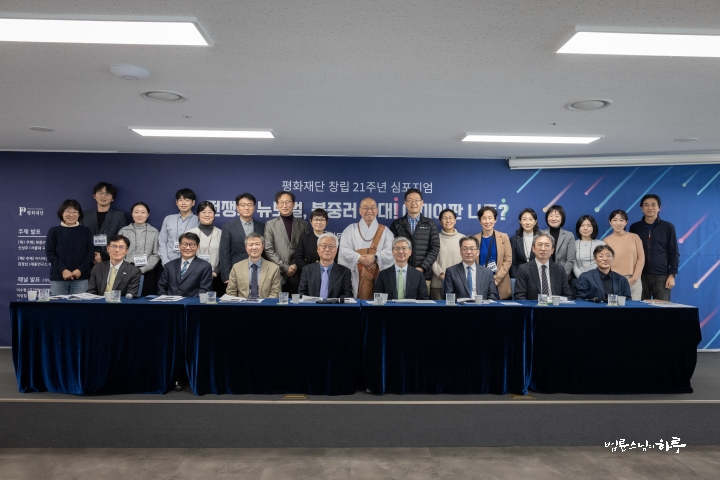

After enjoying refreshments during the break, the Q&A session continued from 3 PM. First, Sunim asked what preparations the Korean government is making regarding North Korea’s mineral resources, such as rare earth elements, which could reduce dependence on China.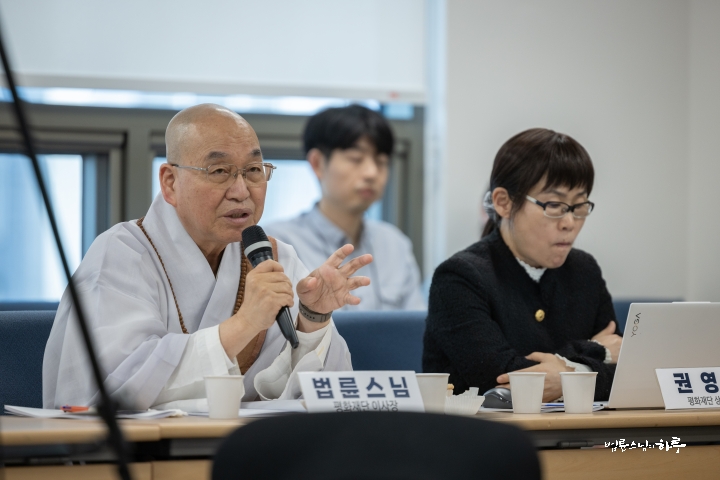
North Korean Mineral Resources That Could Reduce China Dependence – What Is Korea Preparing?
“North Korea is known to have substantial rare earth element reserves, though this hasn’t been finally confirmed. North Korea may be more flexible than China in allowing environmental issues arising from rare earth refining processes. Policy-wise, North Korea also has the advantage of being able to implement immediately once government policy is decided. Therefore, while it cannot completely replace China’s rare earth elements, North Korea could at least partially substitute. I’m curious whether the Korean government or companies have any plans or considerations in this regard. Additionally, North Korea’s major non-ferrous and non-metallic minerals such as graphite, zinc, and magnesite are concentrated in the northeastern region centered on Dancheon in South Hamgyong Province. I’d also like to know if there are any special discussions about this area.”
Jung Sang-sik, President of the Institute for International Trade, took the microphone and provided an answer.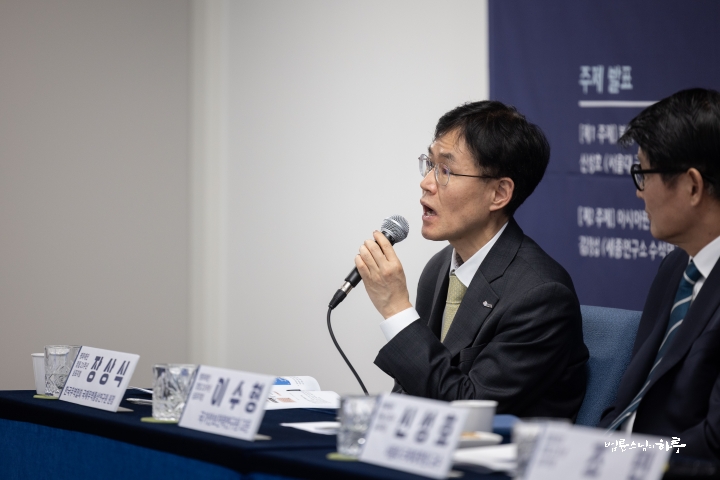
“I handled Russia-related business at my company during the Moon Jae-in administration. At that time, the ‘Nine Bridge’ strategy was promoted as part of the New Northern Policy, and various ideas for energy and mineral projects connecting North Korea, Russia, and China were discussed. Many ideas were reviewed at the conceptual level for developing minerals from North Korea and Russia by combining them with Korean technology through railways connecting Russia and North Korea, including Rajin-Sonbong, even if we don’t directly exchange with North Korea. However, seeing North Korea’s recent unauthorized use of South Korean company facilities in the Kaesong Industrial Complex to produce products, it seems that political and economic cooperation between the two Koreas won’t be easy for the time being.
As you mentioned, North Korea has historically been richer in mineral resources like non-ferrous metals than South Korea. However, the biggest problem with rare earth development is that environmental pollution is difficult to avoid. Fortunately, North Korea has a smaller population than South Korea, and if specific areas are restrictively permitted, development seems quite possible. Recently, China has also been reducing domestic development due to environmental issues and producing more in Mongolia and Myanmar. Among rare earth elements, heavy rare earths are used more than light rare earths, but heavy rare earths are more difficult to process and cause more severe environmental pollution in the process.
We don’t yet know whether North Korea’s rare earth elements are light or heavy, but if they are light rare earths, development could begin within a range that doesn’t impose a heavy environmental burden. If rare earth development begins in North Korea, considering labor costs and extraction and refining costs, it could secure economic viability second only to China. I also think there’s commercial potential since there’s demand within Korea.”
Subsequently, research fellows from The Peace Foundation asked various questions. One research fellow asked whether a new strategy was possible to separate only relatively small North Korea from the North Korea-China-Russia alliance and draw it toward the U.S.-Korea side.
Professor Shin Sung-ho viewed that as U.S. strategic changes have become unpredictable, the possibility of new approaches toward North Korea cannot be completely ruled out. He mentioned Korea’s recent case of directly raising the nuclear-powered submarine issue with Trump at the APEC summit and receiving an unexpectedly positive response, as well as confirming China’s willingness to mediate at the Korea-China summit. He emphasized that amid current changes in the international order, there is room for Korea to attempt its own reverse Kissinger strategy by utilizing the North Korea-China-Russia triangular relationship.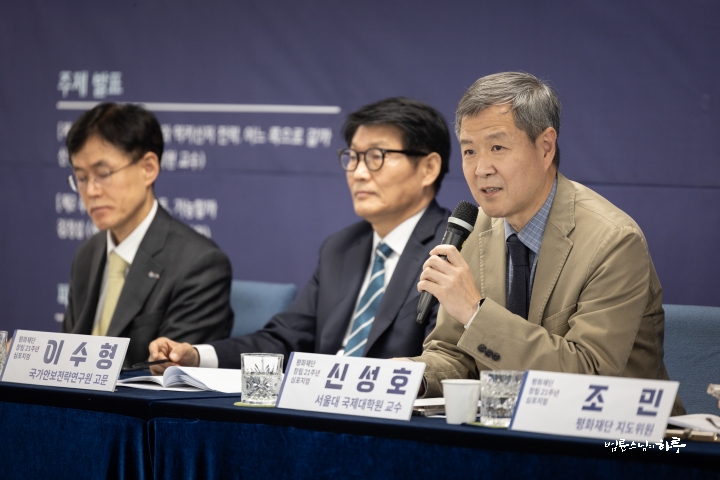
A comprehensive discussion session followed. Anyone could freely express opinions if they had supplementary thoughts or opposing views.

Various topics were discussed, including the actual impact of the North Korea-China-Russia alliance, limitations of Korea-U.S.-Japan cooperation, Korea’s role in a Taiwan contingency, policy changes in Trump’s second term, long-term prospects for Russia and China, and North Korea’s negotiation conditions. Dr. Lee Soo-hyung first emphasized Korea’s need for a perception shift, saying “We must prepare for an era of self-strengthening, breaking away from alliance dependence.” Dr. Kim Jung-seop acknowledged the necessity of Korea-U.S.-Japan security cooperation while pointing out that Korea needs a cool-headed perspective to calculate its own utility and costs since the goals viewed by the U.S. and Japan differ. Professor Lee Jung-chul stated that economic security and defense industries will combine in the future international order, making strengthening Korea’s industrial power the core of diplomatic capability. Dr. Cho Min analyzed the Trump administration’s economic and security strategies, emphasizing the need to accurately read the essence of U.S.-China competition. Dr. Cho Han-beom emphasized that North Korea’s actual goal is not nuclear recognition but sanctions relief and economic normalization, predicting the possibility of small deals. Director Cho Jin-gu examined Japan’s strategic changes and the direction of Korea-U.S.-Japan cooperation, calling for careful diplomatic balance. Professor Shin Sung-ho emphasized that as Korea has now become important to both the U.S. and China, the next 20 years will be a decisive period for establishing new national strategies.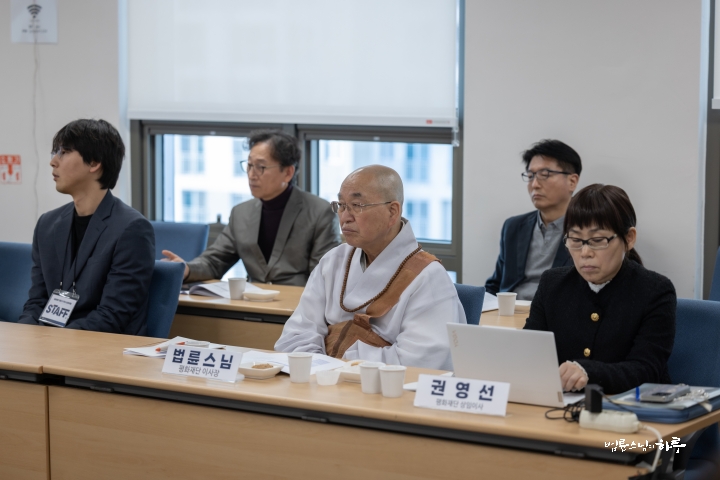
The common message was that as times are rapidly changing, Korea can no longer remain in the mindset of a weak nation from the past, and it’s time to pursue diplomacy as a middle power with its own strength and strategic autonomy. Sunim quietly listened to the experts’ discussions, deeply contemplating what mindset and direction we should take amid the changing international situation.
After concluding the comprehensive discussion, the experts finally asked Sunim for closing remarks. Sunim smiled brightly while sharing his impressions after listening to the four-hour discussion.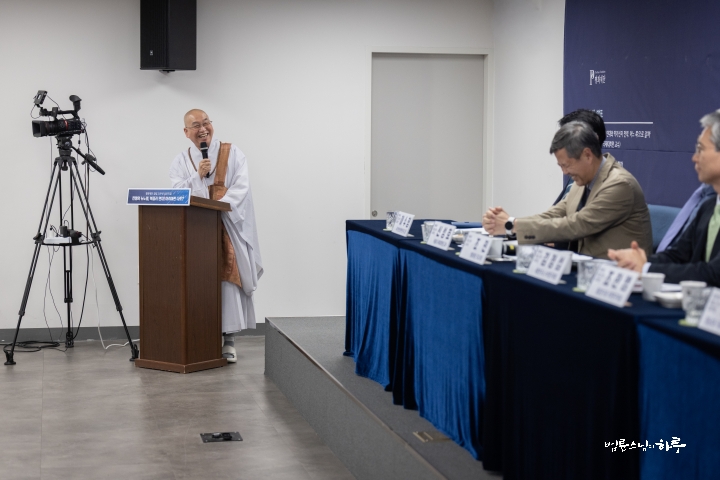
“I listened attentively to all seven speakers. It felt a bit like watching ‘patriotic TV’ after a long time.” (laughter)
In concluding today’s symposium, Sunim emphasized that we should not remain trapped in past grievances but instead choose a greater future. He shared wisdom from the historical integration of Silla and Gaya, demonstrating how conflicts in history can be overcome to open new possibilities.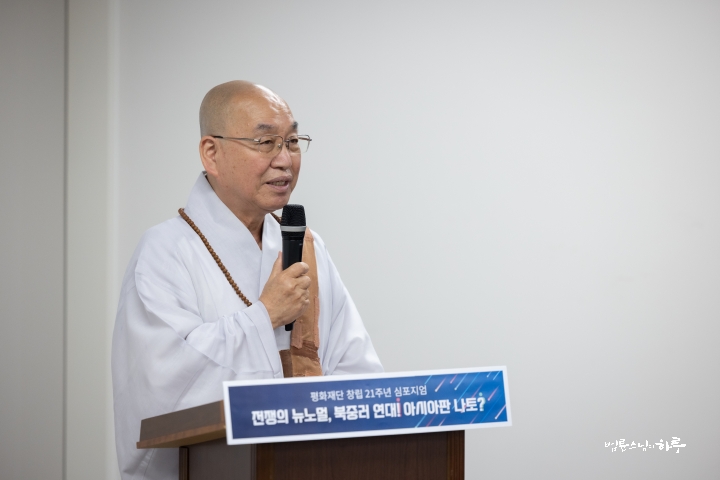
“Today’s discussion emphasized that rather than viewing Korea’s current difficulties or the unstable international situation pessimistically, this is actually an important opportunity for Korea to stand at the center of change. While there were some differences in the panelists’ opinions, overall, hopeful perspectives and insights continued throughout. I wanted to mention at this gathering that domestically, we need to achieve national unity beyond political factional conflicts. However, after listening to various experts’ remarks, I thought it would be more appropriate to introduce a historical example from our past rather than adding my own interpretation of the current situation. This is the integration process of Silla and Gaya.
What Wisdom Is Needed to Move Beyond Resentment and Toward the Future?
In AD 400, when the Gaya-Wa allied forces invaded Silla, Silla faced a major crisis as it was weaker than Gaya in national power and had a lower level of civilization. At this time, King Gwanggaeto the Great of Goguryeo sent an army of 50,000 to help Silla. Goguryeo’s assistance to Silla was not because they were the same people, but a strategic choice to protect Silla and check Baekje, which was behind Gaya. Due to this defeat in war, Gaya gradually declined. About 100 years later, Silla had grown stronger while Gaya had weakened. Within Silla, there were strong calls to attack Gaya to avenge past grievances. Inside Gaya as well, there was resistance: ‘We are a nation that has lasted 500 years. We who once surpassed Silla cannot easily submit to them.’ However, the younger generations of both countries saw the future as more important. The young people of Silla believed, ‘If we fight with Gaya, we will lose the strength to prepare against our real competitors, Goguryeo and Baekje.’ The young people of Gaya also judged, ‘If we continue fighting with Silla, we will eventually perish. Conditional integration is actually the path for our future.’
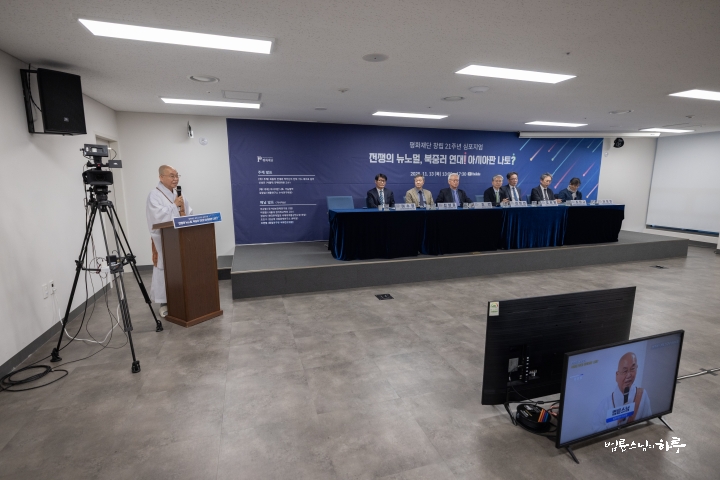
Gaya presented two conditions for integration. First, they requested that the status of Gaya’s royal family be recognized as equal to that of Silla’s royal family. Second, they demanded that Silla accept the faith of Gaya, which was a Buddhist state, and that Silla officially recognize Buddhism before the integration. These conditions were extremely difficult for Silla to accept, as Buddhism was prohibited in Silla at the time. This issue eventually escalated into political conflict, during which Ichadon’s martyrdom occurred. Through Ichadon’s sacrifice, Silla officially recognized Buddhism in 528, and four years later, in 532, the integration of Silla and Gaya was achieved.
This integration became a leap forward for both sides rather than a loss for either. As Gaya’s superior iron technology and military power were absorbed into Silla, figures from Gaya grew to become major military leaders in Silla. The representative figure was General Kim Yu-sin. Having gained this strength, Silla emerged as a central power among the Three Kingdoms through the reigns of King Beopheung and King Jinheung. Afterward, Silla alternated between alliance and conflict with Baekje over the Han River basin, and by securing the Han River and Nakdong River regions, it established itself as a powerhouse among the Three Kingdoms. Furthermore, by actively responding to changes in the surrounding situation, such as the unification of China, Silla ultimately became the protagonist of the unification of the Three Kingdoms. 
The reason I share this story is not to make a historical evaluation that ‘Silla did well.’ The purpose is to examine how Silla, a small tribal state in the east, emerged as the center of our national history. Through this, I want us to consider whether we will continue to view North Korea only as an object of past resentment and competition, or whether we will see them as partners with whom we can explore a future together. Setting our national direction based solely on past emotions may be too narrow a perspective. Similarly, if we remain fixated only on past issues with Japan, we may end up closing off future possibilities ourselves. 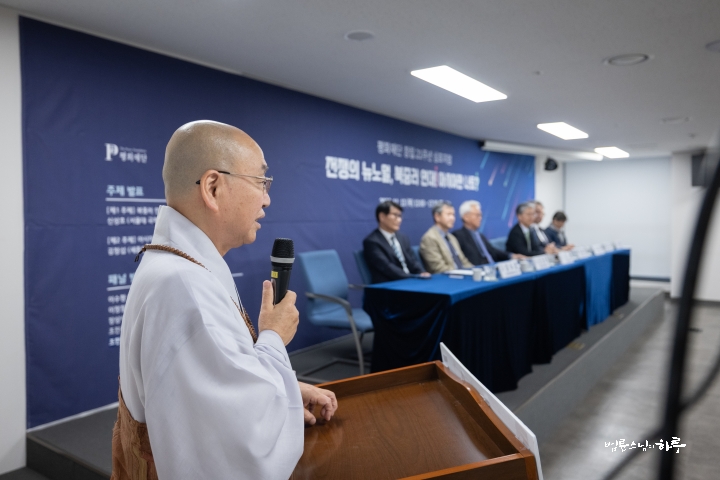
We need to remember that we should not only look to German unification, but that our own history also contains successful examples of integration and cooperation that transcended past resentments. The integration of Silla and Gaya was a decision that looked beyond past grievances toward the future, and above all, it was a result created by the courage and imagination of the younger generation. 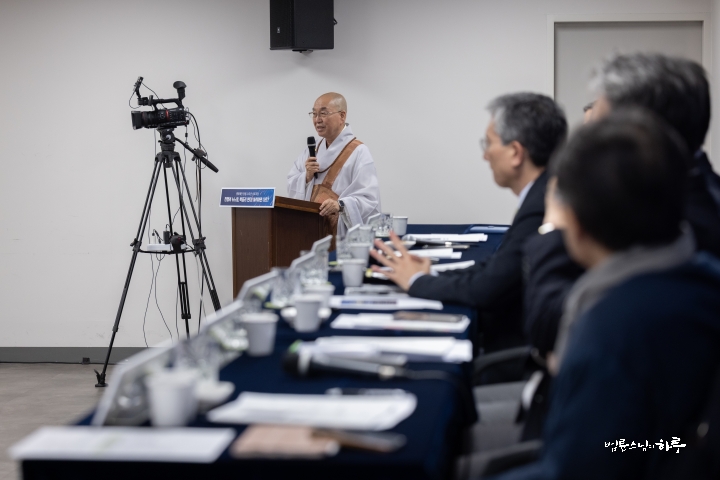
I would like to express my deep gratitude to all the experts who shared valuable insights today. This gathering has once again confirmed that what we need is a broader perspective that looks beyond the past toward the future.”
The Peace Foundation’s 21st anniversary symposium concluded with enthusiastic applause.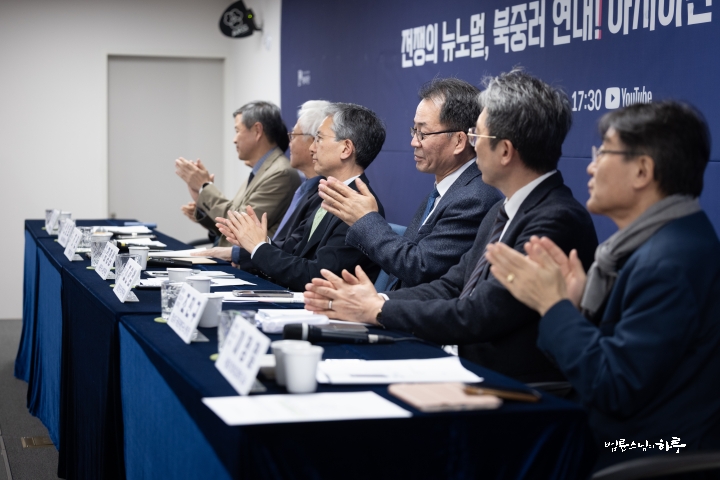
Sunim expressed his gratitude to the experts who had presented with such passion and shook hands with them.
“I enjoyed your presentation. Thank you for sharing so many valuable insights.” 
The Peace Foundation researchers and participating experts continued their unfinished conversations over dinner together, while Sunim bid farewell to the experts and headed to the Jungto Center.
After sunset, Sunim spent the evening indoors proofreading manuscripts and attending to administrative work before concluding his day.
Tomorrow morning, Sunim will have an interview with the Dong-A Ilbo newspaper, followed by the Friday Dharma Q&A live broadcast. In the afternoon, he will give a lecture for employees at the invitation of KC Tech Semiconductor, and in the evening, he will hold a Happy Dialogue Dharma Q&A lecture in Cheonan City.



